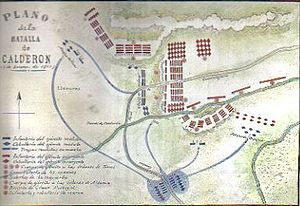- Battle of Calderón Bridge
-
Battle of Calderón Bridge Part of the Mexican War of Independence 
Plan of the Battle of Calderón BridgeDate 17 January 1811 Location Calderón Bridge, Zapotlanejo, Jalisco, Mexico Result Spanish victory Belligerents  Mexico
Mexico Monarchy of Spain
Monarchy of SpainCommanders and leaders Miguel Hidalgo Félix María Calleja del Rey, 1st Count of Calderón Strength 100,000 6,000 Casualties and losses 13,000 1,200 The Battle of Calderón Bridge (Spanish: Batalla del Puente de Calderón) was a decisive battle in the Mexican War of Independence, fought on the banks of the Calderón River 60 km (37 mi) east of Guadalajara in present day Zapotlanejo, Jalisco. Almost 100,000 Mexican revolutionists contributed to the attack, commanded by Miguel Hidalgo, Ignacio Allende, Juan Aldama and Mariano Abasolo. The Royalist forces, made up of little more than 6,000 professional soldiers, and fighting for the King of Spain, were led by Félix María Calleja del Rey, a Spanish military officer and (later) viceroy of New Spain. He was later given the title of conde de Calderón for the victory.[1]
The battle owes its name to the adjoining bridge, and the combatants' objective. The Battle of Calderón Bridge was the last militant episode of the first stage of the War of Independence.
Contents
Overview
Following Hidalgo's failed attempt to take Mexico City in October 1810, insurgent troops retreated toward Guanajuato, pursued by Royalist forces led by General Félix María Calleja. Unable to defend positions at Aculco, where Calleja's army intercepted the insurgents, Hidaldo decided to continue his army's retreat towards Guadalajara.[2]
The insurgent army, numbering approximately 100,000,[3] took up a defensive position at the Bridge of Calderón, where the road from Guanajuato to Guadalajara crossed the Calderón River. Ignacio Allende commanded the troops at the position. Calleja's forces, which numbered only 6,000 but were better equipped than the insurgent forces, arrived at the Bridge on January 16.
As the battle ensued, Royalist artillery struck an insurgent ammunitions wagon, which caused it to explode. The explosion dispersed much of the insurgent force, giving victory to the much smaller but better disciplined and equipped Royalist forces. Insurgent forces fled northwards after losing the battle with Royalist troops following them.
The insurgents' defeat in this battle effectively was a turning point in the War of Independence and resulted in a ten-year delay before insurgent victory and independence could be achieved.
Aftermath
The battle marked the end of the first stage of the war and was noted for the fact that the insurgents fought with more passion than strategy. The insurgent forces were devastated and the events that followed would lead up to the capture and ultimately the sentence of Hidalgo.
The insurgents fled north where, near Zacatecas, Hidalgo was divested of his military command in favour of Allende.[4] In March they received an invitation by the New Leonese general Ignacio Elizondo to meet at the Wells of Baján (Norias de Baján) in Coahuila, from where they would buy armaments in the United States. The first contingent arrived on March 21 with Allende, Aldama, Jiménez and Indalecio, son of Allende. They were welcomed and in an act of ambush, immediately taken prisoner. When the second contingent arrived with Abasolo, they were also captured and taken prisoner. Hidalgo ultimately arrived on horse and was personally apprehended by Elizondo.
The prisoners were taken to Chihuahua where they were tried. Allende, Aldama and Jiménez were shot on June 26, Hidalgo on July 30 and Abasolo was sentenced to life in prison in Cádiz, Spain, where he died in 1816.
Calderón Bridge was declared a Mexican historical monument in 1932.
Notes
- ^ (Spanish) "Calleja del Rey, Félix María," Enciclopedia de México, v. 2. Mexico City: 1996, ISBN 1-56409-016-7.
- ^ Meyer, Jean (1996) (in Spanish). Hidalgo. Mexico: Editorial Clío.
- ^ [1]
- ^ Krauze, Enrique (August 1, 2002) (in Spanish). Siglo De Caudillos (Trilogia Historica de Mexico) (1 edition ed.). Barcelona: TusQuets. ISBN 9706990488.
References
- This article incorporates information from the equivalent article on the Spanish Wikipedia.
- Velázquez, Rogelio (2000) (in Spanish). Historia de México. Mexico City: Editorial Castillo. ISBN 970-20-0019-X.
- Nieto López, José de Jesús (1998) (in Spanish). Historia 3. Mexico City: Editorial Castillo. ISBN 970-642-214-5.
- Fuentes Mares, José (1984) (in Spanish). Historia Ilustrada de México. Mexico City: Editorial Océano. ISBN 968-491-045-2.
- Zárate, Julio (1889) (in Spanish). Mécico a Través de Los Siglos. Mexico City: Editorial Cumbre.
- Villalpando, José Manuel (2002) (in Spanish). Miguel Hidalgo. Mexico City: Editorial Planeta D'Agostini. ISBN 970-726-050-5.
- Hernández, Maite (2003) (in Spanish). Miguel Hidalgo. Madrid: Editorial Dastin. ISBN 84-492-0327-2003.
- Meyer, Jean (1996) (in Spanish). Hidalgo. Mexico: Editorial Clío.
- Young, Philip. History of Mexico, Her Civil Wars, and Colonial and Revolutionary Annals.
- Bancroft, Hubert Hugh. History of Mexico, Vol. 4.
External links
- Official site of the battle (Spanish)
- La batalla en la página (Spanish)(registration required)
- En Red Escolar (Spanish)
- En Monografías (Spanish)
Categories:- Mexican War of Independence
- Battles involving Mexico
Wikimedia Foundation. 2010.
